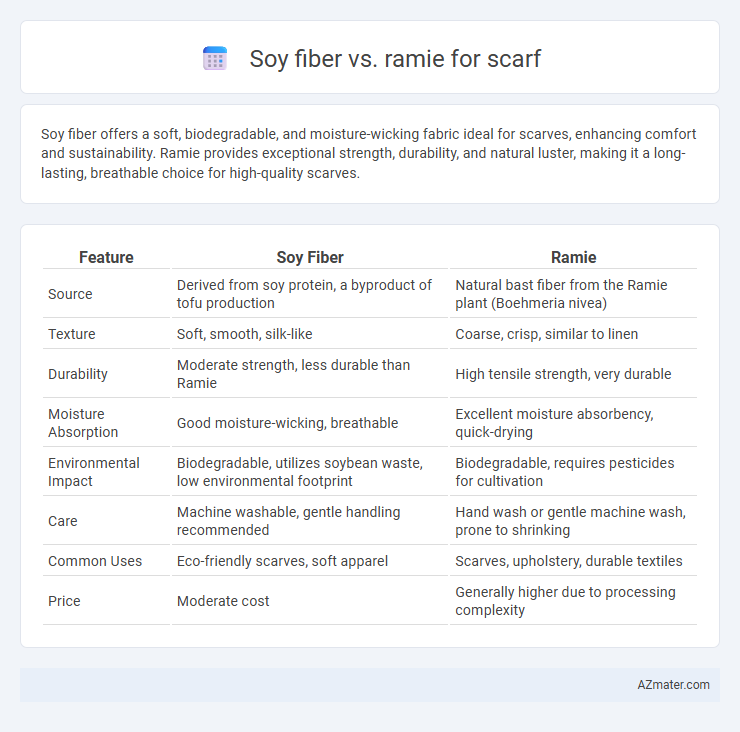Soy fiber offers a soft, biodegradable, and moisture-wicking fabric ideal for scarves, enhancing comfort and sustainability. Ramie provides exceptional strength, durability, and natural luster, making it a long-lasting, breathable choice for high-quality scarves.
Table of Comparison
| Feature | Soy Fiber | Ramie |
|---|---|---|
| Source | Derived from soy protein, a byproduct of tofu production | Natural bast fiber from the Ramie plant (Boehmeria nivea) |
| Texture | Soft, smooth, silk-like | Coarse, crisp, similar to linen |
| Durability | Moderate strength, less durable than Ramie | High tensile strength, very durable |
| Moisture Absorption | Good moisture-wicking, breathable | Excellent moisture absorbency, quick-drying |
| Environmental Impact | Biodegradable, utilizes soybean waste, low environmental footprint | Biodegradable, requires pesticides for cultivation |
| Care | Machine washable, gentle handling recommended | Hand wash or gentle machine wash, prone to shrinking |
| Common Uses | Eco-friendly scarves, soft apparel | Scarves, upholstery, durable textiles |
| Price | Moderate cost | Generally higher due to processing complexity |
Introduction to Soy Fiber and Ramie
Soy fiber, derived from soybean protein, offers a soft, smooth texture with excellent moisture absorption and biodegradability, making it an eco-friendly choice for scarves. Ramie, a bast fiber obtained from the stalks of the Ramie plant, is known for its strength, durability, and silky luster, enhancing the scarf's longevity and sheen. Both fibers provide unique tactile and environmental benefits, influencing the comfort and sustainability of scarves.
Origins and Production Methods
Soy fiber, derived from soybean protein, is produced through a wet spining process that transforms soybean meal into a regenerated protein fiber, emphasizing sustainability and biodegradability. Ramie, a bast fiber extracted from the stalks of the Boehmeria plant native to East Asia, undergoes retting, degumming, and spinning to create its silky, strong threads. Both fibers embody distinct natural origins and traditional production methods that influence their texture and environmental impact in scarf making.
Environmental Impact Comparison
Soy fiber and ramie differ significantly in environmental impact when used for scarves. Soy fiber, derived from soybean hulls, is biodegradable and utilizes agricultural by-products, reducing waste and lowering carbon footprint, while ramie, a natural bast fiber, requires substantial water and chemical inputs during processing, increasing its environmental burden. Choosing soy fiber offers a more sustainable option for eco-conscious consumers seeking biodegradable textiles with reduced resource consumption.
Texture and Softness Evaluation
Soy fiber scarves offer a silk-like smoothness and exceptional softness, making them gentle on the skin and comfortable for all-day wear. Ramie fabric, while durable and breathable, has a coarser texture that can feel stiffer compared to the luxurious softness of soy fiber. In terms of texture and softness, soy fiber is preferred for scarves due to its natural sheen and plush feel, whereas ramie provides a more rustic touch ideal for structured designs.
Breathability and Comfort
Soy fiber offers excellent breathability due to its natural moisture-wicking properties, making it ideal for scarves in warm weather. Ramie fabric provides superior durability and a smooth texture but is less breathable compared to soy fiber, which may affect comfort in high temperatures. For optimal comfort and ventilation, scarves made from soy fiber are preferable, especially in humid conditions.
Durability and Longevity
Soy fiber scarves offer moderate durability with a soft texture but can be prone to wear and pilling over time, making them less ideal for heavy daily use. Ramie, a bast fiber derived from the stalks of the Chinese nettle plant, boasts excellent strength and resistance to stretching, ensuring greater longevity and durability in scarves. Its natural resilience helps Ramie scarves maintain shape and appearance longer, making them a superior choice for durable, long-lasting accessories.
Dyeing and Color Retention
Soy fiber exhibits excellent dye affinity due to its protein-based structure, allowing vibrant and rich color absorption ideal for scarves. Ramie, a cellulose fiber, holds dyes well but may result in slightly less vivid colors compared to soy, with good but moderate color retention over time. Scarves made from soy fiber typically maintain brightness longer through multiple washes, while ramie scarves might show gradual fading under prolonged exposure to sunlight and frequent laundering.
Care and Maintenance Requirements
Soy fiber scarves require gentle hand washing in cold water to maintain their softness and prevent shrinking, avoiding bleach and harsh detergents. Ramie scarves benefit from similar care, but they are more durable and can handle mild machine washing on a delicate cycle, though air drying is recommended to preserve fiber integrity. Both fibers should be stored in a cool, dry place to prevent mildew and maintain their natural luster.
Cost and Market Availability
Soy fiber scarves generally offer a more affordable price point due to lower raw material costs and simpler processing techniques, making them attractive for budget-conscious consumers. Ramie scarves tend to be pricier because of the labor-intensive extraction process and limited large-scale cultivation, which restricts market availability. While soy fiber is increasingly available in mass markets and online stores, ramie scarves often appear in specialty boutiques or eco-friendly collections, reflecting their niche market presence.
Choosing the Best Fiber for Scarves
Soy fiber offers a silky texture and excellent moisture absorption, making it ideal for lightweight, breathable scarves that feel soft against the skin. Ramie, derived from a nettle plant, provides exceptional durability and a natural sheen, ensuring scarves maintain their shape and vibrant appearance over time. Choosing between soy fiber and ramie depends on whether softness and moisture-wicking or strength and luster are the priority for your scarf's intended use.

Infographic: Soy fiber vs Ramie for Scarf
 azmater.com
azmater.com